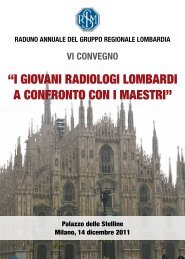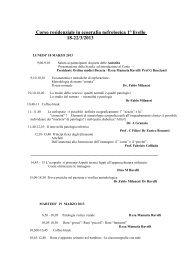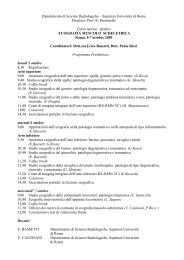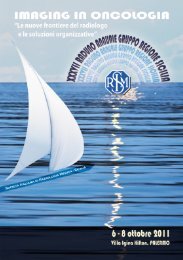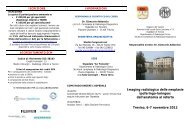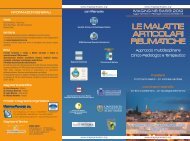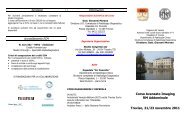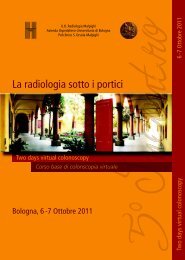Imaging of Pulmonary Viral Pneumonia 1 - SIRM
Imaging of Pulmonary Viral Pneumonia 1 - SIRM
Imaging of Pulmonary Viral Pneumonia 1 - SIRM
- No tags were found...
You also want an ePaper? Increase the reach of your titles
YUMPU automatically turns print PDFs into web optimized ePapers that Google loves.
STATE OF THE ART: <strong>Imaging</strong> <strong>of</strong> <strong>Pulmonary</strong> <strong>Viral</strong> <strong>Pneumonia</strong>FranquetMore than 55 million people die eachyear worldwide, and pneu moniais among the leading causes ( 1 ).<strong>Viral</strong> infections are an increasingly frequentcause <strong>of</strong> pulmonary disease worldwide.Unfortunately, the diagnosis <strong>of</strong>viral pneumonia still relies heavily onclinician suspicion in the proper setting,which is based on host risk factors,presentation, and exposures. Thediagnostic approach involves a consideration<strong>of</strong> the likely pathogens on thebasis <strong>of</strong> the patient’s presenting signsand symptoms and his or her immunologiccondition ( 2 , 3 ). The clinical manifestations<strong>of</strong> most viral infections aresimilar. Although most <strong>of</strong> these infectionsin nonimmunocompromised personsare self-limited, some patients candevelop severe pneumonitis ( 4 ). Clinically,viral pneumonia in adults can bedivided into two groups: so-called atypicalpneumonia in otherwise healthy hostsand viral pneumonia in immunocompromisedhosts ( 5 ). Influenza virus typesA and B account for most viral pneumoniasin immunocompetent adults ( 5 ). Ithas been considered that clinical history,results <strong>of</strong> physical examination,and imaging features cannot enable theprediction <strong>of</strong> the etiologic agent. Furthermore,a pathogen is identified in onlyEssentialsn <strong>Viral</strong> pulmonary infections areclinically important in both immunocompromisedand immunocompetentpatients; despite its limitations,CT is currently the imagingmodality <strong>of</strong> choice for the evaluation<strong>of</strong> pulmonary viral infections.n Although the CT features <strong>of</strong> viralpulmonary infections are usuallynonspecific, precise imaging characterizationis essential; knowledge<strong>of</strong> CT findings has a substantialeffect on the treatment <strong>of</strong>patients suspected <strong>of</strong> having pulmonaryviral infections.n Knowledge <strong>of</strong> the underlyingpathologic characteristics <strong>of</strong>these diseases aids in the differentiation<strong>of</strong> viral infections fromother entities that may haveoverlapping imaging features.up to 50%–64% <strong>of</strong> patients admitted tothe hospital with pneumonia. The recentdevelopment <strong>of</strong> multidetector helical computedtomographic (CT) scanners capable<strong>of</strong> rapid scanning and acquisition<strong>of</strong> thin sections has revolutionized thethin-section CT technique. Volumetricthin-section CT with thin detectors (0.5–0.625 mm) has become the routine inmany institutions. New serologic testshave also come to the aid <strong>of</strong> the clinician,and sophisticated molecular methods arebecoming more commonplace in routinediagnosis <strong>of</strong> acute respiratory diseasein both immunocompetent and high-riskpatients ( 1 , 6 – 8 ). Confirmation <strong>of</strong> the diagnosisand identification <strong>of</strong> the specificagent can be accomplished with use <strong>of</strong>tissue cultures, serologic tests, detection<strong>of</strong> viral antigens within respiratory tractsecretions or blood with use <strong>of</strong> monoclonalantibodies, detection <strong>of</strong> virusassociatedmolecules with use <strong>of</strong> in situhybridization or polymerase chain reaction(PCR), and observation <strong>of</strong> virusinducedchanges cytologically or histologically( 9 , 10 ). The purpose <strong>of</strong> this reviewis to provide a framework with which tobetter understand respiratory viral infections,the diverse clinical settings in whichthey occur, and their potential importancein these varying clinical contexts. Whileacknowledging the less-than-definitivediagnostic role <strong>of</strong> CT in their diagnosis,I will also include discussion <strong>of</strong> thoseconditions in which an understanding <strong>of</strong>the pathologic characteristics can be usefulto the interpretation <strong>of</strong> thin-sectionCT findings. The epidemiology and pathogenesis<strong>of</strong> viral infections are discussedin Appendix E1 (online).Histologic Features <strong>of</strong> <strong>Viral</strong> InfectionsVarious histopathologic patterns <strong>of</strong>lung injury have been described in viralpneumonia. Although some <strong>of</strong> thesepatterns may be relatively unique to aspecific clinical context, others are nonspecificwith respect to either the causeor pathogenesis.Viruses can result in several pathologicforms <strong>of</strong> lower respiratory tractinfection, including tracheobronchitis,bronchiolitis, and pneumonia. Organizingpneumonia is a nonspecific reparativereaction that may be seen in a variety<strong>of</strong> clinical contexts. In other words, organizingpneumonia may result from a variety<strong>of</strong> causes or underlying pathologicprocesses, including viral infections.Most respiratory viruses damage cellsdirectly through cytopathic effects mediatedby means <strong>of</strong> either viral-directedcell lysis or the inhibition <strong>of</strong> host cellRNA, protein, and DNA synthesis. Otherviruses (eg, cytomegalovirus [CMV], adenovirus,or herpesvirus) may producespecific nuclear changes or characteristiccytoplasmic inclusions ( 11 ) ( Fig 1 ).Cytopathic respiratory viruses (eg,influenza, adenovirus, and herpesvirusgroup) cause a virus-specific lung injurypattern. Influenza virus affects the epitheliumdiffusely and, in severe cases, resultsin necrotizing bronchitis and/or bronchiolitisand diffuse alveolar damage.The histologic features <strong>of</strong> influenzapneumonia are epithelial necrosis <strong>of</strong> theairways with submucosal chronic inflammation.Fatal influenza pneumonia representsa necrotizing bronchiolitis withdiffuse alveolar damage, which can behemorrhagic.Adenovirus has its greatest effect inthe terminal bronchioles and may producebronchiolitis or even bronchiectasis( 12 – 14 ). The bronchiolitis may be necrotizingand result in a necrotizing bronchopneumoniasimilar to that seen in severeherpes simplex infection ( 13 ) ( Fig 2 ).The herpes group <strong>of</strong> viruses (herpessimplex, varicella-zoster, CMV, Epstein-Barr virus [EBV]) may cause focal cytopathiceffects in either the airway oralveoli. The histologic features <strong>of</strong> herpessimplex lower respiratory tract infectionPublished online10.1148/radiol.11092149Radiology 2011; 260:18– 39Content codes:Abbreviations:AIDS = acquired immunodefi ciency syndromeCMV = cytomegalovirusEBV = Epstein-Barr virusHMPV = human metapneumovirusHTLV-1 = human T-cell lymphotropic virus type 1PCR = polymerase chain reactionRSV = respiratory syncytial virusSARS = severe acute respiratory syndromeAuthor stated no fi nancial relationship to disclose.Radiology: Volume 260: Number 1—July 2011 n radiology.rsna.org 19




